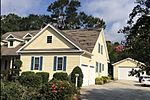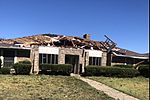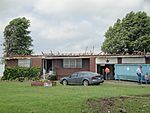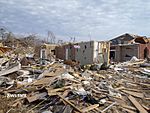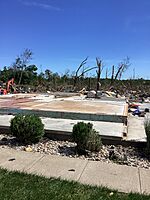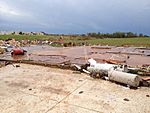Enhanced Fujita scale facts for kids
The Enhanced Fujita scale (or EF-Scale) is a special scale used to measure how strong a tornado is. Instead of measuring the wind directly, it rates a tornado based on the damage it causes to buildings and trees. It is used in the United States, Canada, France, and other countries.
To figure out a tornado's rating, weather experts visit the area after the storm and look closely at the destruction. This is called a damage survey.
The EF-Scale is an updated version of the original Fujita scale (F-Scale). It has six levels, from EF0 for the weakest tornadoes to EF5 for the most powerful. The new scale was created to better match wind speeds with the damage that scientists see in real life. It includes more types of buildings and trees and thinks about how well-built a structure was before the storm hit.
There is also a special rating called "EF-Unknown" (EFU). This is used for tornadoes that happen in areas where there is nothing to damage, like an empty field, so experts can't tell how strong it was.
Contents
Why the Scale Was Updated
The Enhanced Fujita Scale replaced the older Fujita scale, which was created in 1971 by a scientist named Ted Fujita. The new EF-Scale began being used in the United States on February 1, 2007. Canada started using a similar version on April 1, 2013.
Scientists and engineers felt that the wind speeds on the old Fujita scale were not quite right. They studied tornado damage for many years and realized that lower wind speeds could cause the same amount of destruction. So, a team of experts at Texas Tech University worked together to create a more accurate scale.
The new scale was announced in 2006 and used for the first time in 2007 after a group of tornadoes hit central Florida. The strongest of these tornadoes were rated as EF3. Scientists are always working to improve the scale, using new tools like special weather radars and detailed engineering studies to make ratings even more accurate.
How Tornadoes Get Their Rating
The EF-Scale has seven categories, from EFU to EF5. The ratings are based on what experts see after a tornado passes. They look at 28 different things, called Damage Indicators. These can be houses, schools, shopping malls, cell phone towers, or even different types of trees.
For each Damage Indicator, there are several Degrees of Damage. For example, a house might have a few shingles missing (a low degree of damage) or it could be completely wiped off its foundation (the highest degree of damage).
By matching the type of building with the amount of damage, experts can estimate the tornado's wind speeds and give it an EF-rating.
How is it Different from the Old Fujita Scale?
The new EF-Scale is a big improvement over the old F-Scale. Here are the main differences:
- More Realistic Wind Speeds: Scientists found that the wind speeds on the old scale were too high. The EF-Scale uses lower, more accurate wind speed estimates for each level of damage. For example, the old scale said an F5 tornado had winds over 261 mph, but the new scale says an EF5 has winds over 200 mph.
- Considers Construction Quality: The EF-Scale thinks about how well a building was made. A weak, poorly built house that gets destroyed might only get an EF2 rating. But for a strong, well-built house to be destroyed, it would take a much more powerful tornado, like an EF4 or EF5.
- More Detailed Damage Descriptions: The new scale uses 28 different damage indicators to be more precise. This helps experts make a better judgment, especially when a tornado hits different kinds of buildings.
Even with these changes, the goal is the same: to rate a tornado's strength by the evidence it leaves behind.
Weak, Strong, or Violent?
For studies and records, scientists often group the EF-Scale ratings into three main classes. This helps them talk about how powerful tornadoes are in general.
- Weak Tornadoes: EF0 and EF1
- Strong Tornadoes: EF2 and EF3
- Violent Tornadoes: EF4 and EF5
Most tornadoes are in the "weak" category. "Violent" tornadoes are very rare but cause the most destruction.
See also
 In Spanish: Escala Fujita mejorada para niños
In Spanish: Escala Fujita mejorada para niños
- Beaufort scale
- International Fujita scale
- Lists of tornadoes and tornado outbreaks
- List of F4, EF4, and IF4 tornadoes
- List of F5, EF5, and IF5 tornadoes
- Saffir–Simpson hurricane wind scale
- Severe weather terminology (United States)
- TORRO scale
- Tornado intensity and damage
- Wind engineering


